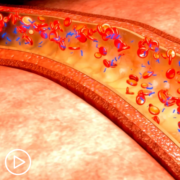Can Bone Marrow Return to Normal After CLL Treatment?
Can Bone Marrow Return to Normal After CLL Treatment? from Patient Empowerment Network on Vimeo.
Is it possible for chronic lymphocytic leukemia (CLL) patients to achieve normal bone marrow after CLL treatment? Expert Dr. Ryan Jacobs explains MRD-undetectable status and the typical time period to deep CLL remission.
Dr. Ryan Jacobs is a hematologist/oncologist specializing in chronic lymphocytic leukemia from Levine Cancer Institute. Learn more about Dr. Jacobs.
Related Programs:

|

Why Is Early Stage Chronic Lymphocytic Leukemia Treatment Delayed? |

|
Transcript:
Lisa Hatfield:
This patient is asking, upon completion of venetoclax (Venclexta) and obinutuzumab (Gazyva) and achieving MRD-undetectable status, how long does it take your bone marrow to achieve improved hemoglobin, hematocrit platelets, white blood cells? And does it always return to normal? And I might add in there just any kind of treatment, does the bone marrow typically return to “normal”? And how long does that take?
Dr. Jacobs:
So the majority of patients treated in the first-line setting and actually in the relapse setting with a combination of venetoclax and obinutuzumab, will have their CLL go into such a deep remission that we cannot detect it in 1 out of 10,000 cancer cells. So that is called MRD-undetectable. Those patients are usually also in complete remission, which means if you look at the bone marrow, you’re not going to see any CLL there. So the majority of patients have their counts normalized while they’re still on the venetoclax. You take it for a year. The complete remission is usually achieved before therapy is completed. And what little, if any CLL is in the bone marrow is not causing a drop in the counts. Now, of course, patients can have the toxicity-reduced counts. And if that’s the case, if it’s a toxicity issue, then it should resolve when you stop treatment. So I would say, usually it does return to normal, if not all…when they’re on therapy, then after therapy. If it’s a relapsed patient that’s seen a lot of therapies though, the bone marrow might never return to normal.
Lisa Hatfield:
How far out are we from curative therapies for CLL patients with the tougher prognostic indicators?
Dr. Jacobs:
So I think curative is an interesting question, and it can mean different things to different people. But we’ve already shown at the most recent American Society of Hematology meeting, when they looked at the average life expectancy of patients without CLL, since the time that ibrutinib (Imbruvica) got approved and then now CLL patients, the survival curves are overlapping. So as of now, it looks like with our newer treatments that a CLL patient should reasonably expect to live a normal life expectancy. Does that mean cure? Well, if by cure you mean, does the disease go away forever with one treatment? We still don’t think we have that therapy for most patients. But we’ll see as we get longer and longer follow-up with some of these newer agents is there are going to be a proportion of patients that never relapse, that ibrutinib is going to have the longest follow up because it was the first one. I was just looking at a poster at the European Hematology Association meeting where they’ve followed patients seven, eight years out and more than half have still not progressed that got ibrutinib as a first-line therapy. So it’s reasonable to think that maybe some will never progress.
Share Your Feedback
Create your own user feedback survey










